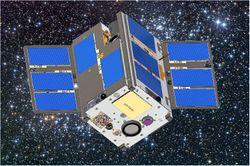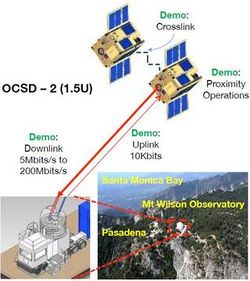Difference between revisions of "The Field of Optical Communications"
Smaldonado (talk | contribs) (→Optical Communications and Sensor Demonstration (OCSD): Added link to detailed OCSD specs) |
Smaldonado (talk | contribs) (Added SOCLBA and a note about SSTP) |
||
| Line 1: | Line 1: | ||
| + | |||
| + | {{satellites-stub}} | ||
| + | |||
==MIT Lincoln Labs LLCD/LADEE== | ==MIT Lincoln Labs LLCD/LADEE== | ||
| Line 23: | Line 26: | ||
| size = 2 x 1.5U | | size = 2 x 1.5U | ||
}} | }} | ||
| + | The Small Spacecraft Technology Program invests in the development and demonstration of a range of technologies and capabilities and engages the talents of a broad community of researchers and technologists from government, industry and academia. Currently, the SSTP funds and/or manages 34 projects that are organized under the four program elements. Of these, two pertain to optical communications. | ||
===Optical Communications and Sensor Demonstration (OCSD)=== | ===Optical Communications and Sensor Demonstration (OCSD)=== | ||
| Line 39: | Line 43: | ||
===Space Optical Communications Using Laser Beam Amplification (SOCLBA)=== | ===Space Optical Communications Using Laser Beam Amplification (SOCLBA)=== | ||
| − | + | The Space Optical Communications Using Laser Beam Amplification (SOCLBA) project will provide a capability to amplify a laser beam that is received in a modulating retro-reflector (MRR) located in a satellite in low Earth orbit. The results of the first year’s work (2014) show amplification factors of 60 times the power of the signal beam. However, there has been little published information since then. The program is led by researchers at the University of Rochester. | |
| − | |||
| − | |||
[[Category: Satellites]] [[Category: Optical Communications]] | [[Category: Satellites]] [[Category: Optical Communications]] | ||
Revision as of 02:07, 22 March 2016
![]() This satellites-related article is a stub. You can help SSI by expanding it.
This satellites-related article is a stub. You can help SSI by expanding it.
MIT Lincoln Labs LLCD/LADEE
JPL 1U Optical Comms Terminal
NASA Small Satellites Technology Project
| OCSD-1 (AeroCube 7A) | |
|---|---|

| |
| Organization | NASA, The Aerospace Corporation |
| Launch provider | ULA - Atlas V |
| Launch date | October 8, 2015 |
| Launch site | Vandenberg AFB |
| Orbit | LEO 1000 x 1200 km x 63.4° |
| Size | 1.5U |
| OCSD-2 (AeroCube 7B/C) | |
|---|---|

| |
| Organization | NASA, The Aerospace Corporation |
| Launch provider | SpaceX - Falcon 9 |
| Launch date | July 2016 (projected) |
| Launch site | Vandenberg AFB |
| Orbit | Unknown |
| Size | 2 x 1.5U |
The Small Spacecraft Technology Program invests in the development and demonstration of a range of technologies and capabilities and engages the talents of a broad community of researchers and technologists from government, industry and academia. Currently, the SSTP funds and/or manages 34 projects that are organized under the four program elements. Of these, two pertain to optical communications.
Optical Communications and Sensor Demonstration (OCSD)
The Optical Communications and Sensor Demonstration (OCSD) project, managed by NASA with payloads built by The Aerospace Corporation, addresses two cross-cutting capabilities of value to many future small spacecraft missions: high-speed optical transmission of data and small spacecraft proximity operations. Optical data rates demonstrated by OCSD are expected to be 200 megabits per second (Mb/s) or higher, a factor of 100 increase over current high-end CubeSat communications systems. [1]
The optical communications system on OCSD differs from other space-based laser communication systems because the laser is hard-mounted to the spacecraft body. The beam is pointed by controlling the orientation of the entire spacecraft. This makes the laser system much more compact than anything previously flown in space. The attitude control system developed for these satellites includes a pair of miniature star trackers, devices that measure the position of stars for navigational purposes. These star trackers were designed to enable pointing to an accuracy of 0.05 degrees, which is 20 times the precision previously demonstrated in a satellite of this size. See here for a detailed overview of the OCSD satellites' system specifications.
OCSD-1
OCSD-1 was launched on October 8, 2015. OCSD-1 was the first of three planned satellites, carrying a 6W fiber laser with a 0.7° divergence half angle designed to downlink with a 30 cm ground telescope. This was later enlarged to 80 cm. [2] Projected data rates from OCSD-1 range from 5 to 100 Mbits/s. On October 30, 2015, NASA acknowledged that the Attitude Determination and Control System (ADCS) onboard the satellite was not functioning properly, preventing a test of the satellite's optical communications systems.[3] OCSD-1 does not contain any fine beam steering systems, relying wholly on the ADCS for optical alignment. The stated minimum ADCS precision for basic link function is 0.15°; NASA and The Aerospace Corporation have claimed the optical link could achieve data rates above 1 Gbit/s with an higher precision ADCS.
OCSD-2 (A/B)
OCSD-2 is scheduled for launch during 2016 aboard a currently unidentified Falcon 9 launch from Vandenberg AFB. The first such launch is currently scheduled for July. OCSD-2 contains the remaining two of the three planned satellites, which will launch as a single 3U unit and separate into 2 independent satellites. The OCSD-2 A and B payloads will attempt satellite-earth and satellite-satellite communications at speeds in excess of 500 Mbit/s, with the primary purpose of demonstrating technologies for satellites operating in proximity to each other. It is unclear what systems will differ between the OCSD-1 and OCSD-2 payloads.
Space Optical Communications Using Laser Beam Amplification (SOCLBA)
The Space Optical Communications Using Laser Beam Amplification (SOCLBA) project will provide a capability to amplify a laser beam that is received in a modulating retro-reflector (MRR) located in a satellite in low Earth orbit. The results of the first year’s work (2014) show amplification factors of 60 times the power of the signal beam. However, there has been little published information since then. The program is led by researchers at the University of Rochester.